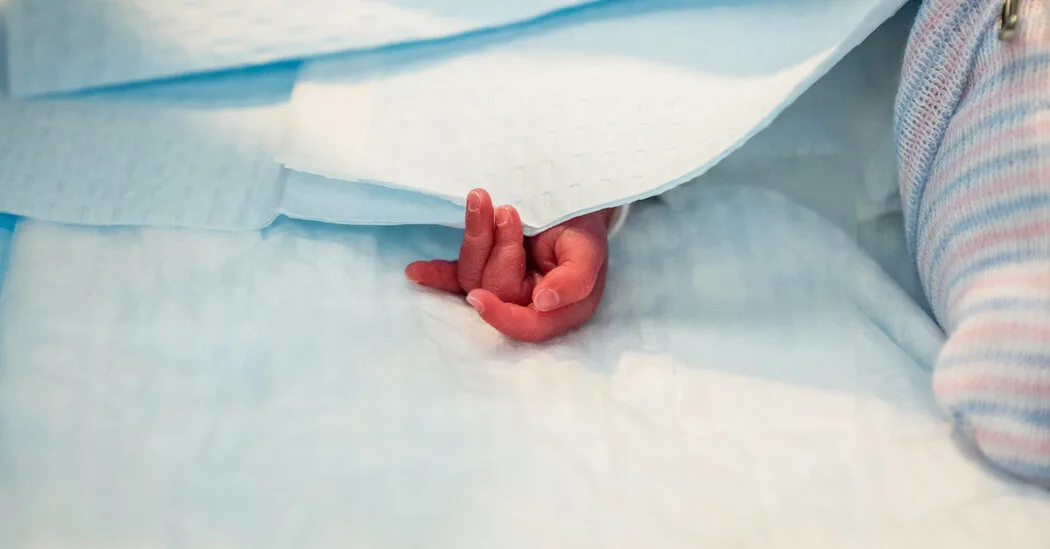
The increases were particularly stark among babies born to Native American, Alaska Native and white mothers in 2022. Rates among Black infants remained highest of all.
The number of American babies who died before their first birthdays rose last year, significantly increasing the nation’s infant mortality rate for the first time in two decades, according to provisional figures released Wednesday by the National Center for Health Statistics.
The spike is a somber manifestation of the state of maternal and child health in the United States. Infant and maternal mortality, inextricably linked, are widely considered to be markers of a society’s overall health, and America’s rates are higher than those in other industrialized countries.
The rates are particularly poor among Black and Native American mothers, who are roughly three times as likely to die during and after pregnancy, compared with white and Hispanic mothers. Their infants face up to double the risk of dying, compared with white and Hispanic babies.
Overall life expectancy has declined in the United States in recent years, too, affecting white Americans as well as people of color. The declines were driven in part by the Covid-19 pandemic.
The increase in infant mortality comes after a century of public health improvements, in which rates consistently and gradually declined almost every year with few exceptions, said Danielle M. Ely, a health statistician with the N.C.H.S. and the report’s lead author.
The report did not delve into the cause of the increase, but most of the babies born in 2022 were conceived in 2021, when maternal deaths rose by 40 percent because of the pandemic and many pregnant women were taken ill.
“Seeing an increase that hits the statistical significance mark indicates that this was a bigger jump than we’ve had in the last 20 years, and that is something we need to keep an eye on to see if it’s just a one-year anomaly or the start of increasing rates,” Dr. Ely said.
One of the more disturbing findings in the new report was an increase in infant mortality among babies born to women ages 25 to 29. The rate increased to 5.37 per 1,000 live births last year, up from 5.15 deaths per 1,000 live births in 2021. The cause is not known.
Rates did not change for women in other age groups, even those who generally experience higher infant mortality rates, such as women younger than 20, those 20 to 24 and women 40 and older.
Dr. Elizabeth Cherot, an OB-GYN who is president and chief executive of the March of Dimes, said she was surprised and disappointed by the new infant mortality figures, and called for taking a much closer look at the data to try to identify the underlying causes.
“We were making strides, but these trends are clearly going in the wrong direction,” she said.
The rise occurred at the tail end of the pandemic, after a year that had a sharp increase in maternal mortality and maternal illness, she added. Pregnancy complications are now more prevalent, as more women begin pregnancies with underlying medical conditions like high blood pressure, obesity and diabetes.
Serious complications that pose a risk to both mother and baby, like pre-eclampsia, also have become more common. But it is difficult to pin the rise in infant mortality on any one factor, she added, without examining the data in more detail.
“We were just coming out of Covid,” Dr. Cherot said. “We were doing a lot of telemedicine. Did that shift something? Were protocols changing? Was access a bigger issue? We know mental health can also have an impact. A lot of things changed in the last three years.”
For families who lose a baby, the death can be life altering.
Erika Nolting Young’s baby died less than two hours after birth. Ms. Young, 37, a business strategy consultant in Rancho Palos Verdes, Calif., had experienced a normal, healthy pregnancy, with no sign at any point that something was wrong.
She expected to deliver on Aug. 17, 2022, and when labor did not start spontaneously, made plans to be induced a week later. But just hours before Ms. Young and her husband, Kris, were supposed to go to the hospital, they received a call saying that the maternity ward was full and there were not enough nurses, so she would have to wait.
The hospital called her in the next day, and began the induction with a drug that caused intense labor and rapid progression to full dilation.
In the final stage of labor, the monitors picked up a deceleration in the baby’s heart rate — and then a sudden further deceleration.
The baby was born “really gray and floppy,” Ms. Young recalled. “They threw her on my chest for a split second, and her eyes were closed. I knew something was wrong instantly.”
Doctors tried to save the newborn, a girl who was named Sommer, but she died shortly afterward, Ms. Young said: “We went home to a house with a baby room and no baby.” The Youngs still do not know what caused Sommer’s death.
Some 20,538 infants like Sommer died in 2022, representing a 3 percent increase over the 19,928 babies who died in 2021. The infant mortality rate — defined as the number of babies who die before they are a year old for every 1,000 live births — also increased by a statistically significant 3 percent last year, to 5.6 infant deaths per 1,000 live births, up from 5.44 deaths per 1,000 live births in 2021, according to the new report.
The mortality rate of babies who were between 4 weeks and a year old increased by 4 percent, while neonatal mortality rates — that of babies less than a month old — increased by 3 percent.
Rates increased significantly among both premature babies born before 37 weeks of gestation and those born extremely early, at less than 34 weeks of gestation.
Overall, the statistically significant increases in mortality rates were seen only among male infants, whose survival rates have always been slightly lower than those among females.
Black infants have the highest mortality rate in the United States, rising slightly last year to 10.86 deaths per 1,000 live births, from 10.55 deaths per 1,000 live births in 2021, an increase that was not statistically significant.
By contrast, the infant mortality rates of both white and Native American and Alaska Native babies increased by statistically significant amounts last year.
Among white infants, the figure rose to 4.52 deaths per 1,000 live births from 4.36 deaths per 1,000 live births in 2021. Among Native American and Alaska Native babies, the figure increased to 9.06 deaths per 1,000 live births from 7.46 deaths per 1,000 live births in 2021.
The two leading causes of infant deaths that were more prevalent last year were bacterial sepsis, caused by the body’s overwhelming reaction to an infection, and maternal health complications.
Since infant deaths are relatively rare events involving small numbers of babies, statistically significant changes cannot easily be seen from year to year at the state level. Nevada was the only state that had a statistically significant decline in infant mortality, while four states — Georgia, Iowa, Missouri and Texas — experienced statistically significant increases in infant mortality last year.
Texas banned abortions after six weeks of pregnancy in 2021, the first of the four states to do so. But in interviews on Wednesday, experts said the data was unclear as to whether, or to what extent, this may have played a role in infant deaths the following year. The other states implemented bans in 2022, after the Supreme Court overturned Roe v. Wade.


